Drive down virtually any busy street in your city and count the restaurants. It staggers the mind to see all the different choices we consumers have each day to get our preferred 3 meals. Fast food, Vietnamese food, Home-cooked food, Food served by tuxedoed waiters by candlelight, Take-out food. There are seemingly thousands of food-service formats.
I have chosen 3 (restaurant-related) jewellry display principles to review in hopes of helping you see your stores selection, display and shopping experience, from a different perspective.
- Don’t display your merchandise “buffet-style.” When you visit a cafeteria or a buffet line, you are presented all today’s food choices presented in identically sized, stainless steel bins (usually separated from you by a glass partition) You simply pick and choose what you want with little or no interaction with the serving staff. You point, they spoon, you pay. The servers’ role is very passive. Their job is limited to refilling the bins and dishing it up on demand. No one calls them salespersons because they are not. They don’t care which entrée you choose even though some items before them in those trays, might be a bit higher priced and possibly more profitable for the owner. It is a self-serve experience.
If your store presents the merchandise you offer without INTENTION you are possibly at risk of having a buffet style presentation. All the trays are the same size designed to be self-shopped . High end pieces from your selection are presented like all the rest. Your showcases shout “I don’t care which item you buy.” Your sales staff is silent because the client waved them off 5 minutes ago. Instead, have a plan for your cases. Decide what you want me to see first when I step up to the case. Train your staff to take an active role in helping your clients choose. (Remember how many times in your favorite higher-end restaurant, you have ordered the “Special” described to you by the waitperson. Their short explanations with those emotional adjectives and filled with exotic sauce descriptions have worked their magic.) Your showcase is a workbench for your sales team. Organize it with intention to close the sale of the items you want your clients to buy. Consider my “Top 10 gift idea” concept in your cases as a great way to apply the idea of “intention.” A recent client made 17 sales from the top 10 items in the first 3 days after we implemented it! (Send me an email requesting a copy of the idea, if you need it.)
- Deemphasizing dollars and cents makes sense.
In a Cornell University study, researchers found that menu items priced at “14” significantly outsold the same items in parallel test stores priced at “$14” or “$14.00.” Dollar signs mean money. Numbers (even zeros!) also subconsciously, mean money. Do not put your prices in a larger or more dominant typeface either. The price is just an extension of the information about the jewellery.
- Always include a expensive bottle of wine (that is way out of your average customers price range) on your wine list. Ever look at a wine list and comment to your companion about the $1500 bottle of wine included on the front page? Who pays those kinds of prices? Answer: Hardly anyone, but the high-ticket item (called a “decoy” in the food trade) does prompt people to open their pocketbook more generously and order a $75 instead of a $40 bottle. People do not like buying the cheapest or the most expensive item on a list…or in a display. They tend toward the middle items. In my consulting practice, I call this the “Goldilocks” decision making process. Not too hot, not too cold, just right!
Always have a “larger than normal sized” pair of diamond stud earrings (or a diamond solitaire or a diamond anniversary band) in your case. Trust me, you’ll sell more of the next smaller size, the “middle item.” Make that choice at full-margin and at about a 20% higher price than your average sales ticket from that showcase because you are going to sell more of it. Once in a while, you’ll even sell the “decoy”.
Selling jewellery from a retail shop these days is a difficult business at best. Don’t make it harder than it has to be by ignoring the “human nature of the customer.” Use their tendencies, perceptions and their subconscious decision making processes to help you close the sale of the items you want most to sell. Contact me if you have questions, comments or if I can help you in any way.
Oops, I gotta go. I’m late for a lunch date. I wonder what the special is today?




